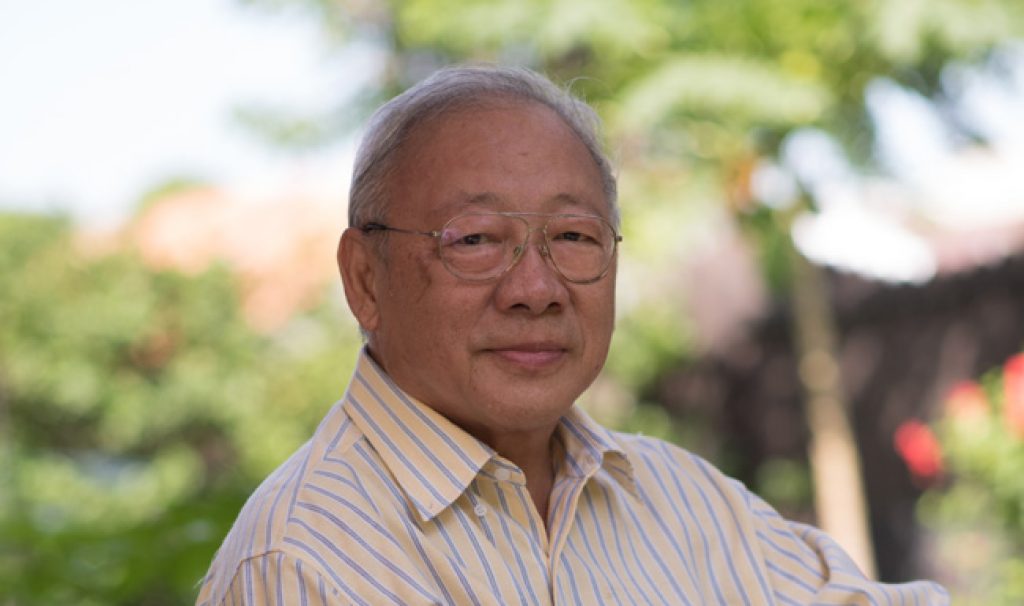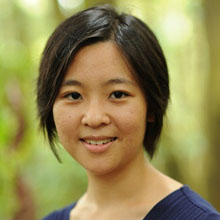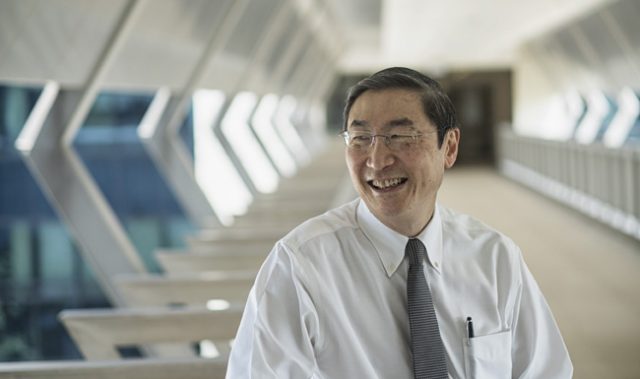
AsianScientist (Jul. 26, 2016) – Sturdy in his Bermuda shorts and rubber clogs, Wong Poh Poh, retired associate professor of geography at the National University of Singapore (NUS), emerges from around a corner in the garden of his rambling Hougang home holding a potted plant: Avicennia marina, a robust, common species that, belying its name, thrives even inland.
Professor Wong admires the versatility of the grey mangrove, as it is more commonly known. It provides animals with food; humans with burning fuel; and coastlines with shelter from high-energy waves.
“You want some mangroves in your garden, you just come and collect them,” he says. “The day I’m no longer around, these seedlings will be my standing testimony that mangroves can grow in my garden.”
Like the grey mangrove, the 70-year-old has thrived across a range of roles. He is most noted for being a coordinating lead author of the seminal work by the Intergovernmental Panel on Climate Change (IPCC), the international body of scientists that reviews and reports on the latest climate-change data for policymakers.
In 2007, IPCC and Al Gore, former US vice president, shared a Nobel Peace Prize for disseminating knowledge on man-made climate change. It was the highlight of a four-decade career studying coasts—specifically, how human activity such as tourism reshapes the coastline, and how the coastline itself influences human activity.
The accidental geographer
Coastal geomorphology is a field that chose Professor Wong. As a student at the University of Singapore, he did so well in geography classes and so enjoyed the subject that the department, short of Singaporean lecturers, sent him to McGill University in Canada for a PhD.
But what exactly would he study?
“Singapore has no big rivers, no forests, no deserts, no glaciers, and no mountains,” Professor Wong laughs. “The only thing left was beaches.”
But by the 1970s, when he returned, most of Singapore’s natural beaches had vanished beneath reclamation, so Professor Wong looked to other field sites, for example studying how monsoons affected beaches on Malaysia’s east coast.
Shortly thereafter, he was inspired to apply his hard-science skills to coastal tourism. The Association of American Geographers had just published a path-breaking paper on the geography of tourism.
“Tourism used to be at the fringe of serious studies,” Professor Wong says. “Nobody studied it except at business school.”
His interest was in the interplay between resorts and coasts—how the geomorphology of a coast affects the layout, nature and management of a resort; and subsequently how resort development affects the coast.
As one of the first geographers to carve out a niche in coastal tourism, Professor Wong surveyed resorts around Asia, including beach resorts on rocky shores that had hauled sand in to create artificial beaches; resorts which had installed their own corals; and resorts with manmade freshwater and marine swimming pools along the coast. In 1992, he wrote a research article on the impact of sea level rise on coasts.
In 1997, the Singapore government asked him to review IPCC’s Regional Impacts of Climate Change special report. He was invited to be a lead author for IPCC’s third assessment report in 2001, and for the fourth report in 2007—which ultimately won the Nobel—he was a coordinating lead author. He reprised his role as a coordinating lead author for the fifth report published in 2014.
Success has cemented his faith in unconventional pursuits.
“Don’t pick areas which too many people are working on,” Professor Wong advises budding researchers. “Pick areas that are new and interesting, where you can contribute.”
Disappearing beaches
Singapore, of course, became a fascinating case study in coastal development. From 1965 till today, the country’s land area has grown by almost 25 percent from 580 sq km to 720 sq km.
Singapore has only a few natural coasts remaining, such as on Pulau Ubin and a rocky shore at Labrador Park.
“The government wanted it [reclamation], so we had no choice,” he says, without rancour.
What’s more important is to make sure the reclamation does not have adverse impacts, he thinks. For example, sediment moves through Singapore waters roughly from east to west; a large reclamation project at Changi, such as for the airport terminals, blocks the natural movement of sediment and results in erosion at East Coast, of which he despairs.
Singapore’s coasts are certainly vulnerable to long-term environmental shifts. For one, some of the reclaimed land has subsided and the breakwaters have to be raised. Meanwhile, to safeguard against the threat of rising sea levels, Singapore has drawn up new coastal regulations. For instance, some of the existing reclaimed land on which Changi Airport’s Terminal 5 will be built must be heightened to at least 2.25 metres above the highest recorded tide.
In order to properly guard against climate change, says Professor Wong, Singapore needs to share more of its coastal-vulnerability information with citizens to properly guard against climate change. This includes data obtained by LiDAR (light detection and ranging) systems, which use remote laser measurements to make detailed topographic maps.
“In other countries they share information openly,” he says. “Coastal vulnerability studies are paid for by the taxpayer and should not be restricted to press releases or announcements in parliament.”
Such information would be useful to insurance firms, developers and, most importantly, ordinary people who live near the sea. Singapore needs to prepare for climate change, and not just by raising land reclamation levels and building seawalls. For example, it will have to decide what space should be given over to coastal ecosystems as sea levels rise and they retreat further inland.
And it needs laws to govern so-called “managed retreat”, he adds.
“There’s a lot of interest from lawyers. If you have a piece of land which is under water in 10 or 20 years, what are your property rights—are they on land or in the sea? Who will compensate you?”
Tales from the field
Professor Wong, of course, knows a thing or two about nature’s ferocity. He was once caught in the middle of the US’s worst pre-Katrina hurricane.
In 1969, as a graduate student, he spent a few months at a field site called Santa Rosa Island, a sandy island with dunes off the Florida coast. When Hurricane Camille hurtled through Florida at more than 200 kph, he and his colleagues hunkered down in a local hotel.
“You could see pebbles being blown horizontally,” he says. “In the hotel, we had to tape down the glass doors with sticky tape to make sure that they wouldn’t shatter into small pieces if they broke.”
The hurricane deposited shells and marine animals along the beach. Professor Wong, a “kampung boy” who had grown up fishing and swimming at Changi and Pasir Ris, was loath to waste a perfectly good source of food.
“So I looked for things that were closed, and found a lot of pen shells,” he says. “I took a knife and opened them up and cut off the muscles, boiled them and ate them.”
That hardiness came in handy when he was stranded in Bintan while doing some surveying in the 1990s, before it had developed.
“We were in a place called the Pasir Panjang coast, towards the eastern side of Bintan,” he says. “It was dark, and we didn’t have water or food. But I had a penknife, and we managed to scrounge and find two old coconuts which we opened up and shared.”
Youth out of touch with nature
Unfortunately, he says, most young Singaporeans do not share his familiarity with nature. His three sons are lucky enough to have grown up in a house with a large garden, hibiscus plants, one chiku tree and many banana trees, but most young people are not—and in the process an intrinsic geographic identity has seeped away.
“Few Singaporeans call themselves islanders when our country is small and is indeed an island,” laments Professor Wong.
“I have been to many island nations, some bigger than Singapore, and their people are proud to be islanders. We’re proud to be a world port but forget that it is based on the coastline and water.”
To resuscitate our island consciousness and general nature awareness, Professor Wong has many suggestions. These include maintaining Pulau Ubin’s rural environment; introducing compulsory gardening and gardens in schools; extending gardening schemes in housing precincts; and encouraging nurseries to stock seeds and potted seedlings of vegetables and fruits (and not just flowers).
At a larger level, he believes Singapore needs more “non-hype” outreach by the likes of the Botanic Gardens and the Zoo.
“We spend one billion dollars on the Gardens by the Bay and yet it cannot teach the average Singaporean kid about our nature,” he says. “Something is seriously wrong here.”
For his part, Professor Wong has recently introduced mangrove planting to local schools. He has also recently initiated a project to set up mangrove restoration sites in South-east Asian countries such as Cambodia, Indonesia and the Philippines. These sites would serve as fish nurseries, storm surge buffers, and help stem coastal erosion. They would also become a source of livelihood for villagers, who could manufacture mangrove-planting modules from coir or jute, and benefit from eco-tourism.
The self-described “professional beach bum” has made a career out of going to the beach. Now, it is time to give back, he says.
“The more satisfying thing is contributing something back to the coastal community.”
This feature is part of a series of 25 profiles, first published as Singapore’s Scientific Pioneers. Click here to read the rest of the articles in this series.
———
Copyright: Asian Scientist Magazine; Photo: Cyril Ng.
Disclaimer: This article does not necessarily reflect the views of AsianScientist or its staff.













